System Analysis and Design
VerifiedAdded on 2022/12/23
|19
|1672
|28
AI Summary
The main aim of this project is the design and implementation of a management system to ease the functionalities and the way in which work is carried out. Entities are linked together to form a visualization of the working system. The methodologies involved in the design and implementation of a system are well laid out.
Contribute Materials
Your contribution can guide someone’s learning journey. Share your
documents today.

SYSTEM ANALYSIS AND DESIGN 1
Affliate Information
Affliate Information
Secure Best Marks with AI Grader
Need help grading? Try our AI Grader for instant feedback on your assignments.

SYSTEM ANALYSIS AND DESIGN 2
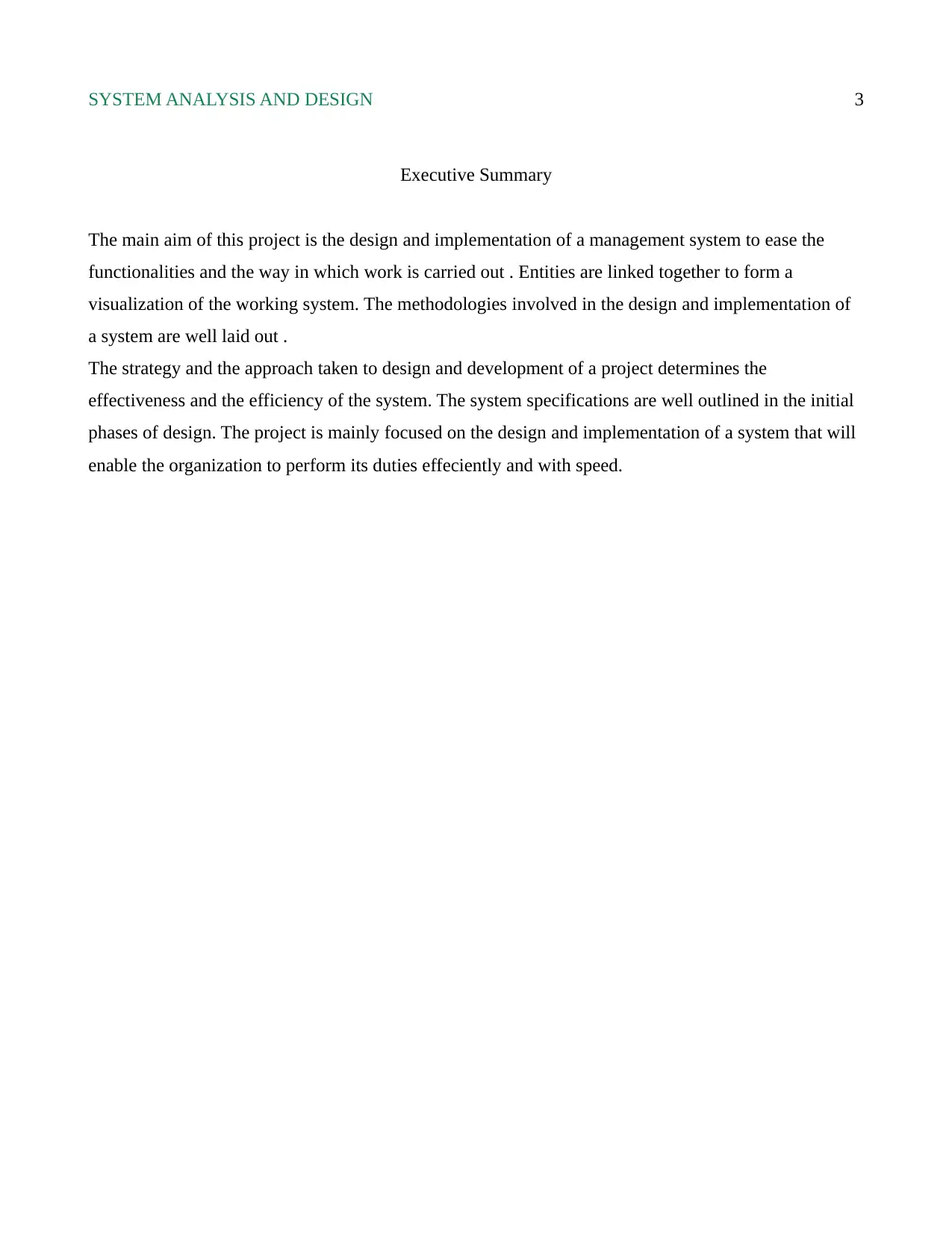
SYSTEM ANALYSIS AND DESIGN 3
Executive Summary
The main aim of this project is the design and implementation of a management system to ease the
functionalities and the way in which work is carried out . Entities are linked together to form a
visualization of the working system. The methodologies involved in the design and implementation of
a system are well laid out .
The strategy and the approach taken to design and development of a project determines the
effectiveness and the efficiency of the system. The system specifications are well outlined in the initial
phases of design. The project is mainly focused on the design and implementation of a system that will
enable the organization to perform its duties effeciently and with speed.
Executive Summary
The main aim of this project is the design and implementation of a management system to ease the
functionalities and the way in which work is carried out . Entities are linked together to form a
visualization of the working system. The methodologies involved in the design and implementation of
a system are well laid out .
The strategy and the approach taken to design and development of a project determines the
effectiveness and the efficiency of the system. The system specifications are well outlined in the initial
phases of design. The project is mainly focused on the design and implementation of a system that will
enable the organization to perform its duties effeciently and with speed.
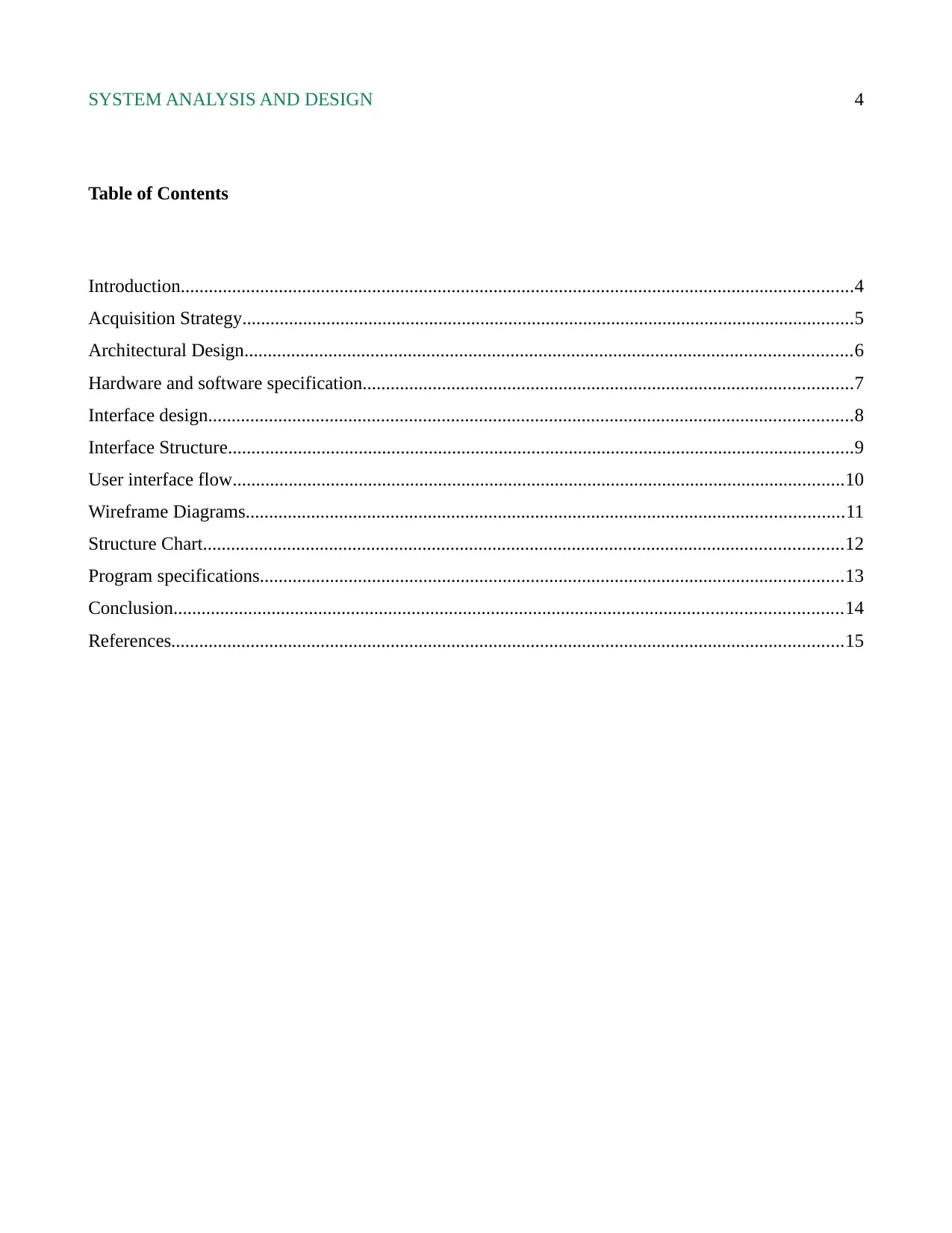
SYSTEM ANALYSIS AND DESIGN 4
Table of Contents
Introduction................................................................................................................................................4
Acquisition Strategy...................................................................................................................................5
Architectural Design..................................................................................................................................6
Hardware and software specification.........................................................................................................7
Interface design..........................................................................................................................................8
Interface Structure......................................................................................................................................9
User interface flow...................................................................................................................................10
Wireframe Diagrams................................................................................................................................11
Structure Chart.........................................................................................................................................12
Program specifications.............................................................................................................................13
Conclusion...............................................................................................................................................14
References................................................................................................................................................15
Table of Contents
Introduction................................................................................................................................................4
Acquisition Strategy...................................................................................................................................5
Architectural Design..................................................................................................................................6
Hardware and software specification.........................................................................................................7
Interface design..........................................................................................................................................8
Interface Structure......................................................................................................................................9
User interface flow...................................................................................................................................10
Wireframe Diagrams................................................................................................................................11
Structure Chart.........................................................................................................................................12
Program specifications.............................................................................................................................13
Conclusion...............................................................................................................................................14
References................................................................................................................................................15
Secure Best Marks with AI Grader
Need help grading? Try our AI Grader for instant feedback on your assignments.

SYSTEM ANALYSIS AND DESIGN 5
Introduction
The methodologies employed in the design and implementation of a system determine the efficiency
and effectiveness. The requirements include both hardware and software which aid in the development
and design. Software tools are used in the design of the system to fit into user design.
Agile methodologies are used in the development phases to create an iterative and interactive system
with the users (Whitten, Bentley and Dittman, 2010). The methodology must be clearly stated and
followed in phases to ensure an intuitive design. All the paradigms stated to influence the way in which
the software system is developed.
Both software and hardware specifications must be laid out, each of the specifications is used for a
specific purpose in the development and design of the interfaces. User interaction with the system is
through a computer system that is able to render the interface to the user.
The look and feel for the system should be appealing to ensure that the users are able to interact easily
with the application. A nice user interface is the core design factor considered before the initial
development phase.
Introduction
The methodologies employed in the design and implementation of a system determine the efficiency
and effectiveness. The requirements include both hardware and software which aid in the development
and design. Software tools are used in the design of the system to fit into user design.
Agile methodologies are used in the development phases to create an iterative and interactive system
with the users (Whitten, Bentley and Dittman, 2010). The methodology must be clearly stated and
followed in phases to ensure an intuitive design. All the paradigms stated to influence the way in which
the software system is developed.
Both software and hardware specifications must be laid out, each of the specifications is used for a
specific purpose in the development and design of the interfaces. User interaction with the system is
through a computer system that is able to render the interface to the user.
The look and feel for the system should be appealing to ensure that the users are able to interact easily
with the application. A nice user interface is the core design factor considered before the initial
development phase.
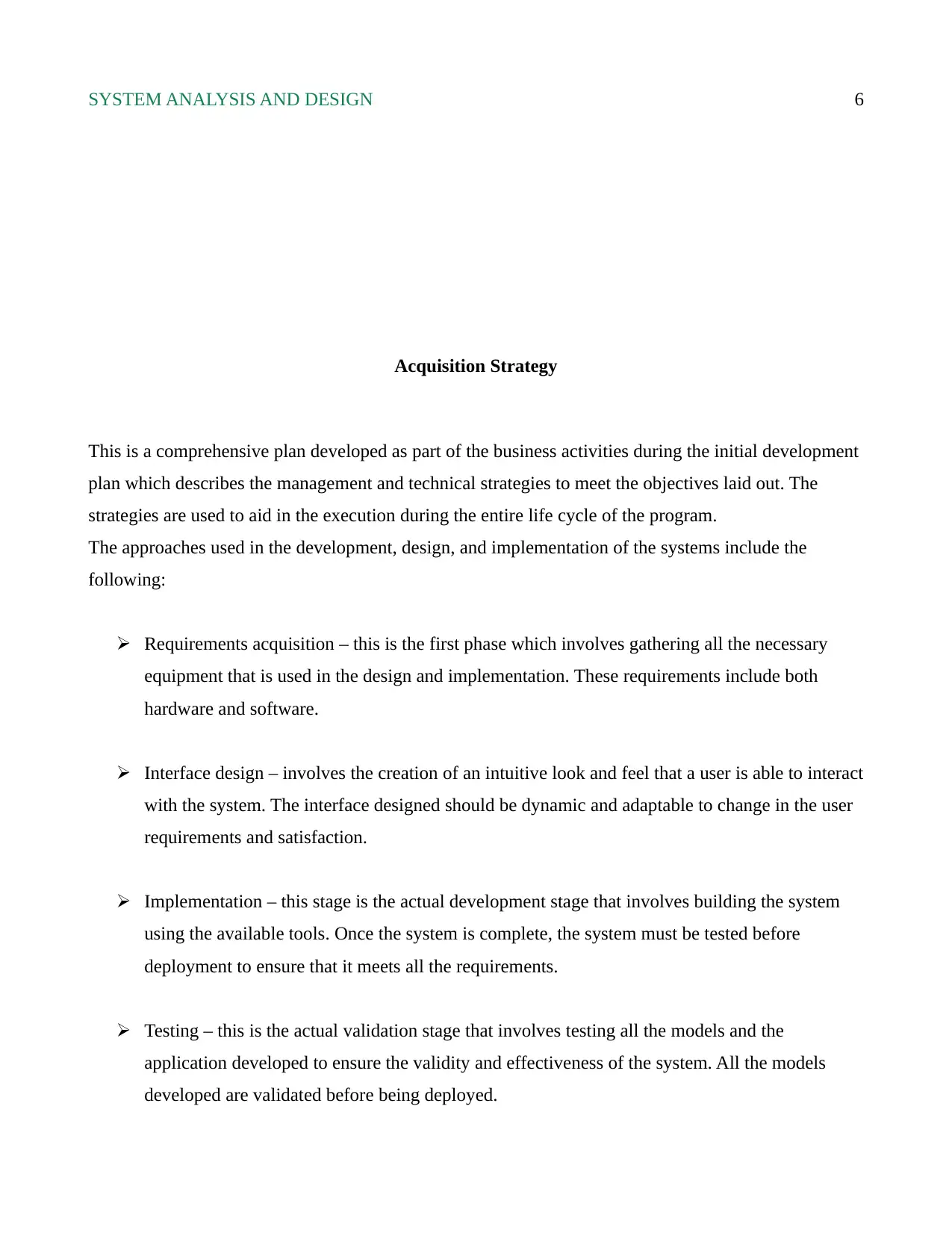
SYSTEM ANALYSIS AND DESIGN 6
Acquisition Strategy
This is a comprehensive plan developed as part of the business activities during the initial development
plan which describes the management and technical strategies to meet the objectives laid out. The
strategies are used to aid in the execution during the entire life cycle of the program.
The approaches used in the development, design, and implementation of the systems include the
following:
Requirements acquisition – this is the first phase which involves gathering all the necessary
equipment that is used in the design and implementation. These requirements include both
hardware and software.
Interface design – involves the creation of an intuitive look and feel that a user is able to interact
with the system. The interface designed should be dynamic and adaptable to change in the user
requirements and satisfaction.
Implementation – this stage is the actual development stage that involves building the system
using the available tools. Once the system is complete, the system must be tested before
deployment to ensure that it meets all the requirements.
Testing – this is the actual validation stage that involves testing all the models and the
application developed to ensure the validity and effectiveness of the system. All the models
developed are validated before being deployed.
Acquisition Strategy
This is a comprehensive plan developed as part of the business activities during the initial development
plan which describes the management and technical strategies to meet the objectives laid out. The
strategies are used to aid in the execution during the entire life cycle of the program.
The approaches used in the development, design, and implementation of the systems include the
following:
Requirements acquisition – this is the first phase which involves gathering all the necessary
equipment that is used in the design and implementation. These requirements include both
hardware and software.
Interface design – involves the creation of an intuitive look and feel that a user is able to interact
with the system. The interface designed should be dynamic and adaptable to change in the user
requirements and satisfaction.
Implementation – this stage is the actual development stage that involves building the system
using the available tools. Once the system is complete, the system must be tested before
deployment to ensure that it meets all the requirements.
Testing – this is the actual validation stage that involves testing all the models and the
application developed to ensure the validity and effectiveness of the system. All the models
developed are validated before being deployed.
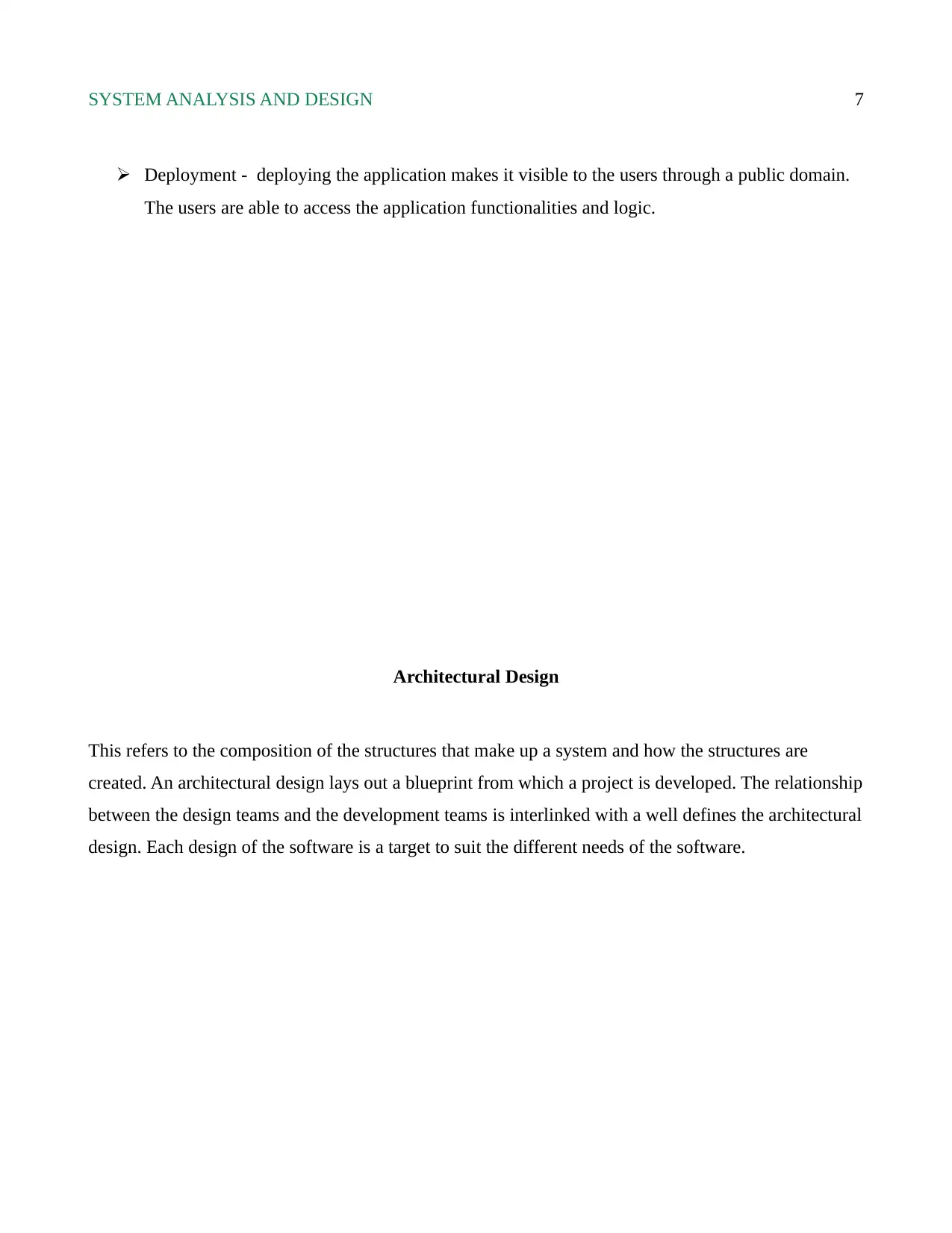
SYSTEM ANALYSIS AND DESIGN 7
Deployment - deploying the application makes it visible to the users through a public domain.
The users are able to access the application functionalities and logic.
Architectural Design
This refers to the composition of the structures that make up a system and how the structures are
created. An architectural design lays out a blueprint from which a project is developed. The relationship
between the design teams and the development teams is interlinked with a well defines the architectural
design. Each design of the software is a target to suit the different needs of the software.
Deployment - deploying the application makes it visible to the users through a public domain.
The users are able to access the application functionalities and logic.
Architectural Design
This refers to the composition of the structures that make up a system and how the structures are
created. An architectural design lays out a blueprint from which a project is developed. The relationship
between the design teams and the development teams is interlinked with a well defines the architectural
design. Each design of the software is a target to suit the different needs of the software.
Paraphrase This Document
Need a fresh take? Get an instant paraphrase of this document with our AI Paraphraser

SYSTEM ANALYSIS AND DESIGN 8
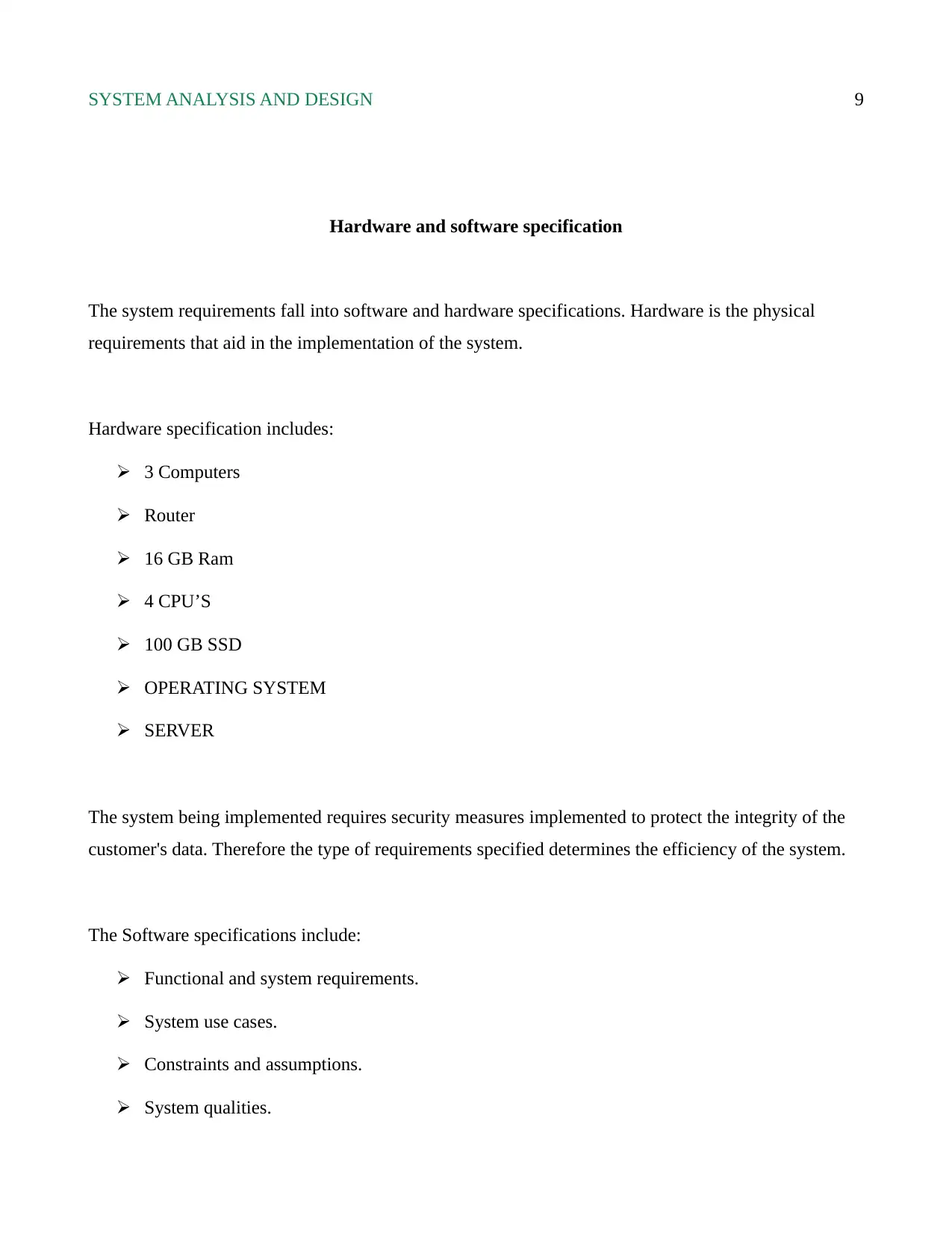
SYSTEM ANALYSIS AND DESIGN 9
Hardware and software specification
The system requirements fall into software and hardware specifications. Hardware is the physical
requirements that aid in the implementation of the system.
Hardware specification includes:
3 Computers
Router
16 GB Ram
4 CPU’S
100 GB SSD
OPERATING SYSTEM
SERVER
The system being implemented requires security measures implemented to protect the integrity of the
customer's data. Therefore the type of requirements specified determines the efficiency of the system.
The Software specifications include:
Functional and system requirements.
System use cases.
Constraints and assumptions.
System qualities.
Hardware and software specification
The system requirements fall into software and hardware specifications. Hardware is the physical
requirements that aid in the implementation of the system.
Hardware specification includes:
3 Computers
Router
16 GB Ram
4 CPU’S
100 GB SSD
OPERATING SYSTEM
SERVER
The system being implemented requires security measures implemented to protect the integrity of the
customer's data. Therefore the type of requirements specified determines the efficiency of the system.
The Software specifications include:
Functional and system requirements.
System use cases.
Constraints and assumptions.
System qualities.
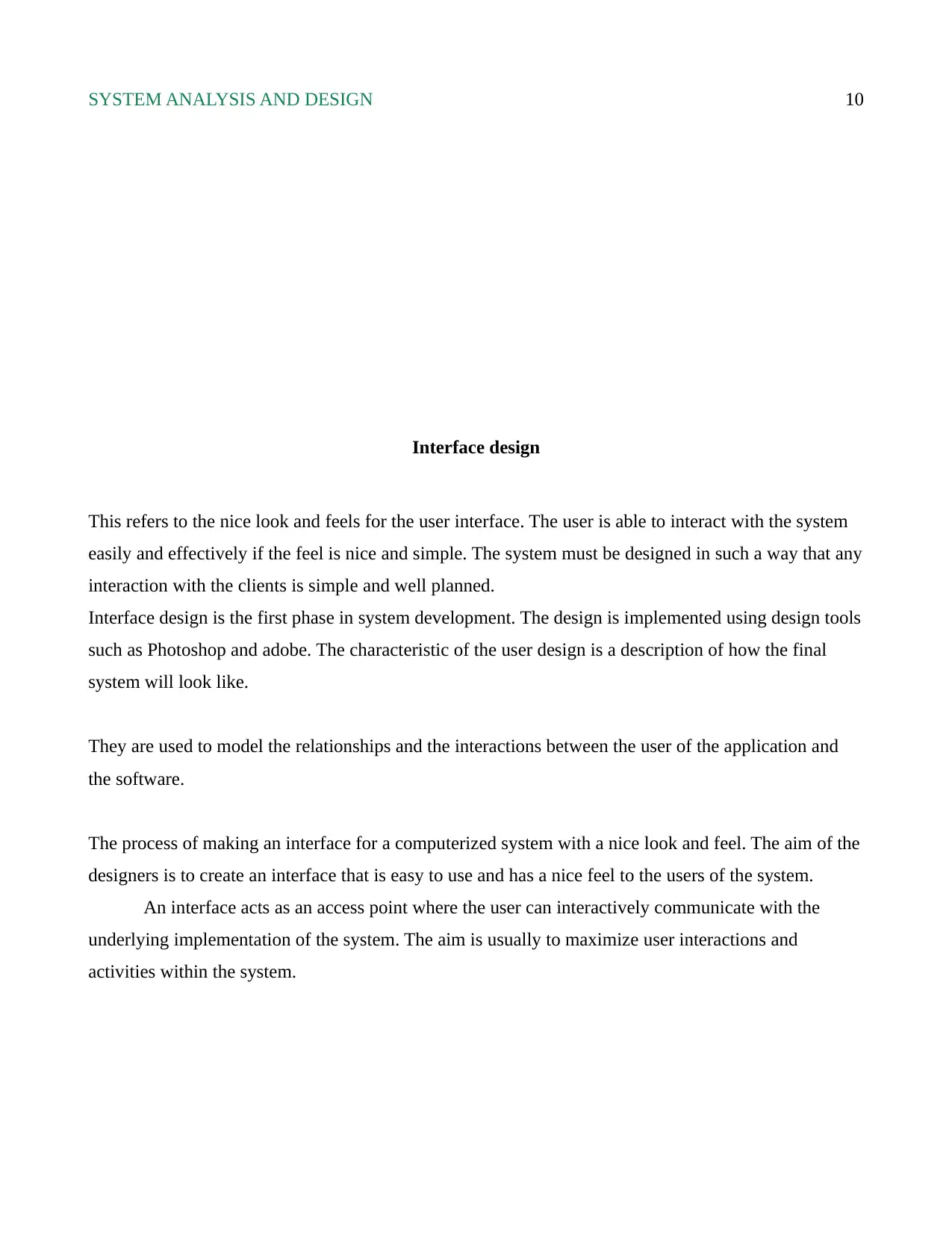
SYSTEM ANALYSIS AND DESIGN 10
Interface design
This refers to the nice look and feels for the user interface. The user is able to interact with the system
easily and effectively if the feel is nice and simple. The system must be designed in such a way that any
interaction with the clients is simple and well planned.
Interface design is the first phase in system development. The design is implemented using design tools
such as Photoshop and adobe. The characteristic of the user design is a description of how the final
system will look like.
They are used to model the relationships and the interactions between the user of the application and
the software.
The process of making an interface for a computerized system with a nice look and feel. The aim of the
designers is to create an interface that is easy to use and has a nice feel to the users of the system.
An interface acts as an access point where the user can interactively communicate with the
underlying implementation of the system. The aim is usually to maximize user interactions and
activities within the system.
Interface design
This refers to the nice look and feels for the user interface. The user is able to interact with the system
easily and effectively if the feel is nice and simple. The system must be designed in such a way that any
interaction with the clients is simple and well planned.
Interface design is the first phase in system development. The design is implemented using design tools
such as Photoshop and adobe. The characteristic of the user design is a description of how the final
system will look like.
They are used to model the relationships and the interactions between the user of the application and
the software.
The process of making an interface for a computerized system with a nice look and feel. The aim of the
designers is to create an interface that is easy to use and has a nice feel to the users of the system.
An interface acts as an access point where the user can interactively communicate with the
underlying implementation of the system. The aim is usually to maximize user interactions and
activities within the system.
Secure Best Marks with AI Grader
Need help grading? Try our AI Grader for instant feedback on your assignments.
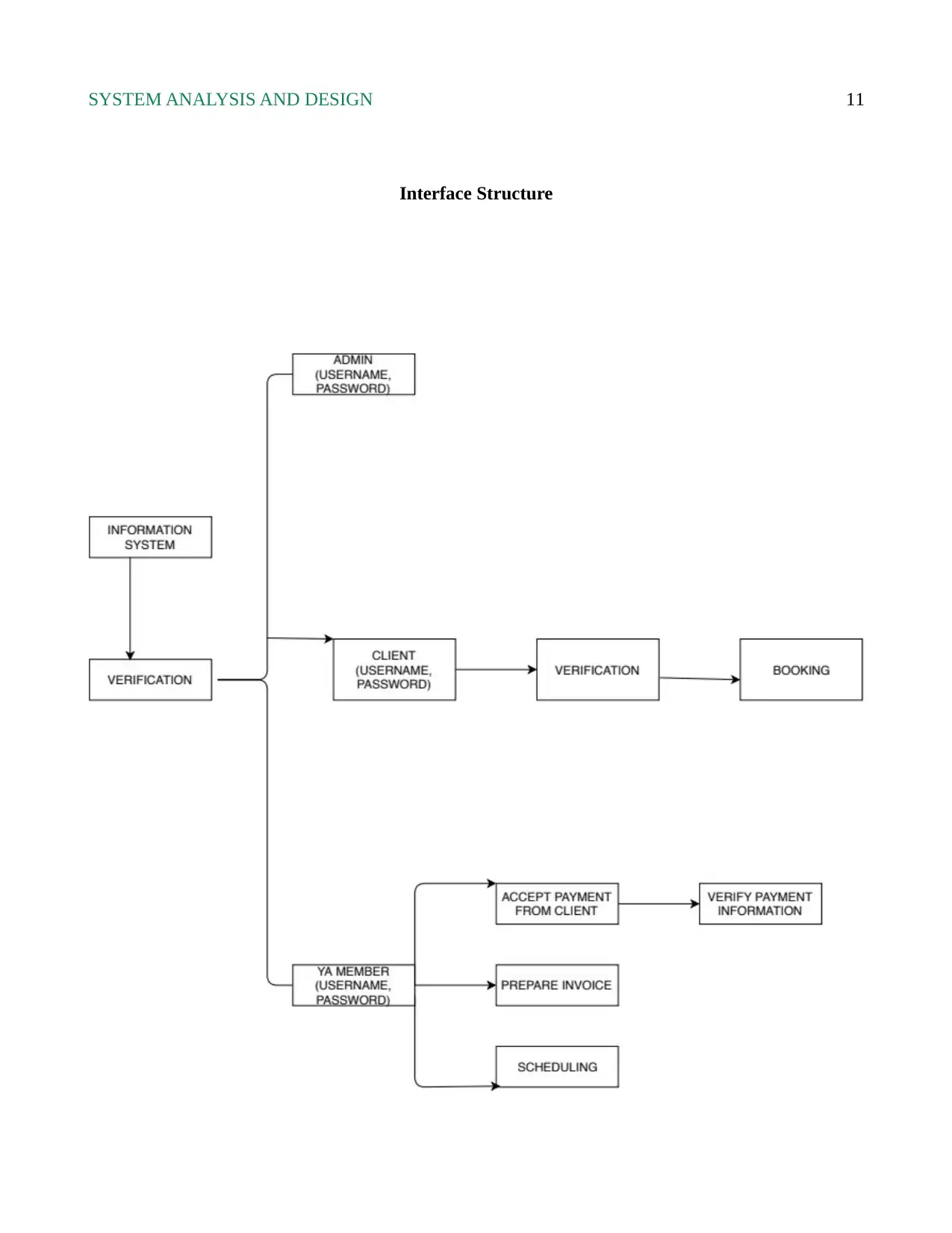
SYSTEM ANALYSIS AND DESIGN 11
Interface Structure
Interface Structure

SYSTEM ANALYSIS AND DESIGN 12
User interface flow
A graphical representation that shows how a user will navigate and traverse through the interface
design. Outlines and show the different pages of the interface design and how the pages are linked
together. The representation is characterized by screens and windows that navigate to the pages. The
graphical representations explain how a user will be able to navigate the software.
User interface flow
A graphical representation that shows how a user will navigate and traverse through the interface
design. Outlines and show the different pages of the interface design and how the pages are linked
together. The representation is characterized by screens and windows that navigate to the pages. The
graphical representations explain how a user will be able to navigate the software.
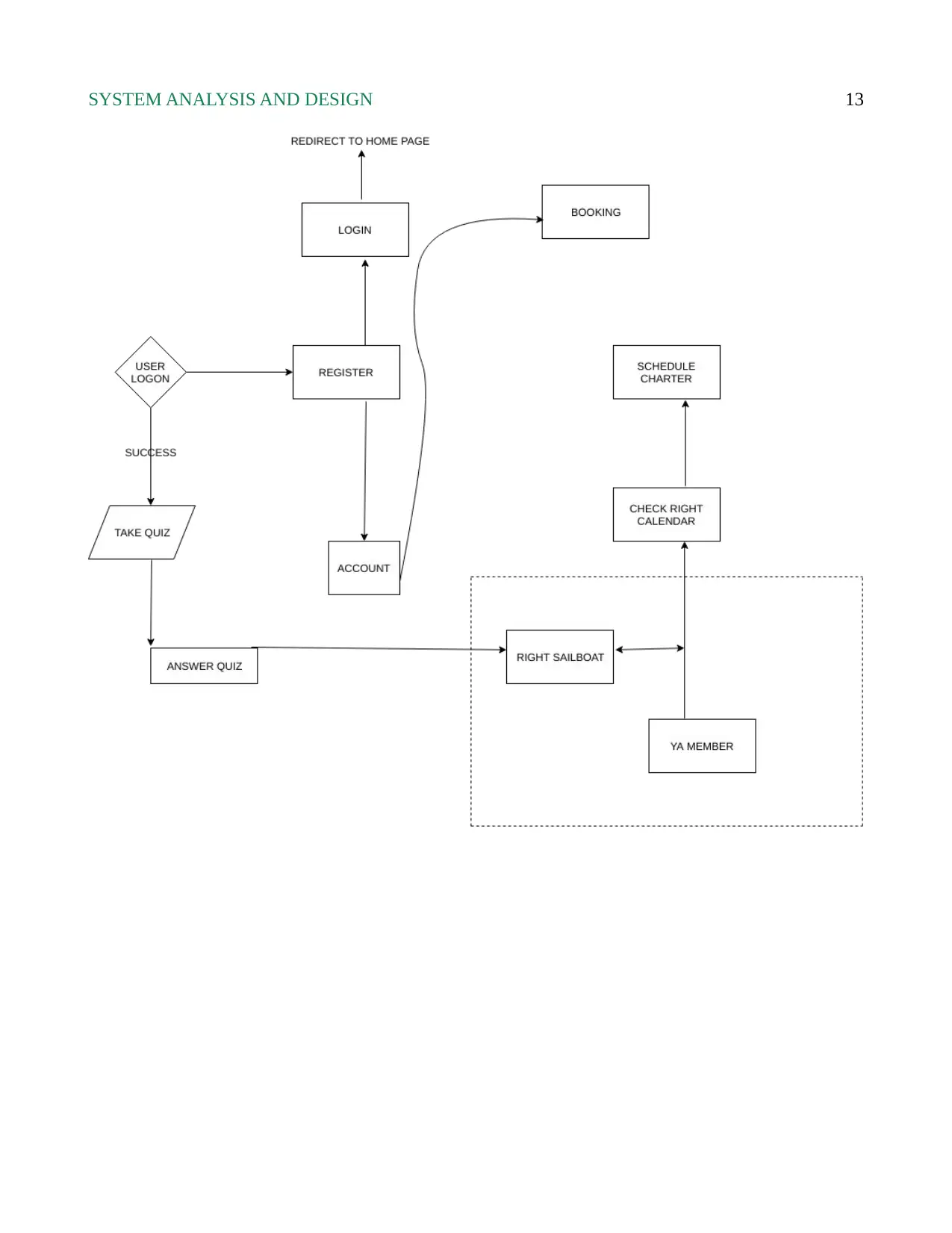
SYSTEM ANALYSIS AND DESIGN 13
Paraphrase This Document
Need a fresh take? Get an instant paraphrase of this document with our AI Paraphraser
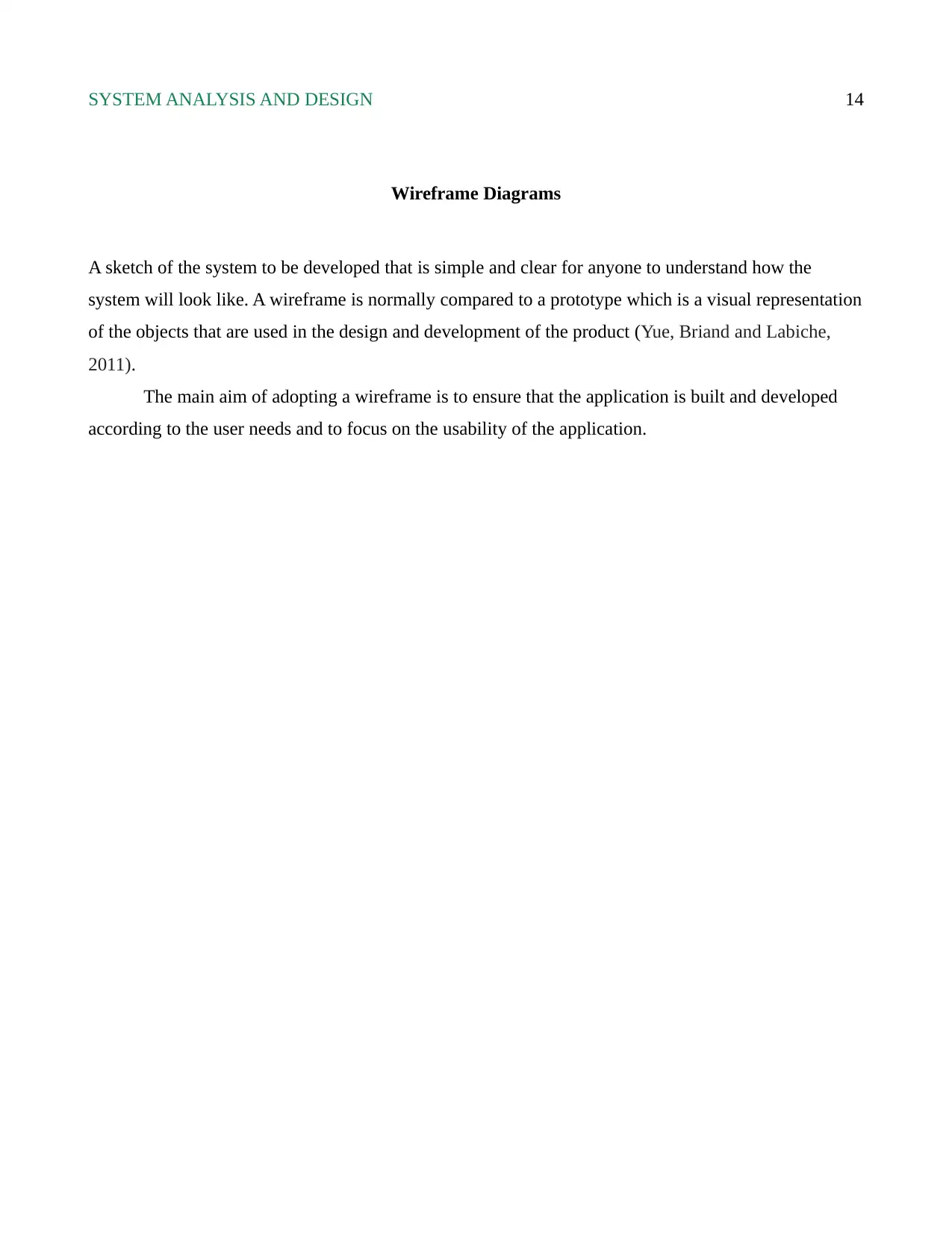
SYSTEM ANALYSIS AND DESIGN 14
Wireframe Diagrams
A sketch of the system to be developed that is simple and clear for anyone to understand how the
system will look like. A wireframe is normally compared to a prototype which is a visual representation
of the objects that are used in the design and development of the product (Yue, Briand and Labiche,
2011).
The main aim of adopting a wireframe is to ensure that the application is built and developed
according to the user needs and to focus on the usability of the application.
Wireframe Diagrams
A sketch of the system to be developed that is simple and clear for anyone to understand how the
system will look like. A wireframe is normally compared to a prototype which is a visual representation
of the objects that are used in the design and development of the product (Yue, Briand and Labiche,
2011).
The main aim of adopting a wireframe is to ensure that the application is built and developed
according to the user needs and to focus on the usability of the application.

SYSTEM ANALYSIS AND DESIGN 15
Structure Chart
An organizational chart that creates a visualization of how the management is broken down to the
lowest levels in the management. The chart is broken down into modules with each of the modules
representing connection between the entities in the organization. The chart is represented in the form
top-down design model.
Structure Chart
An organizational chart that creates a visualization of how the management is broken down to the
lowest levels in the management. The chart is broken down into modules with each of the modules
representing connection between the entities in the organization. The chart is represented in the form
top-down design model.
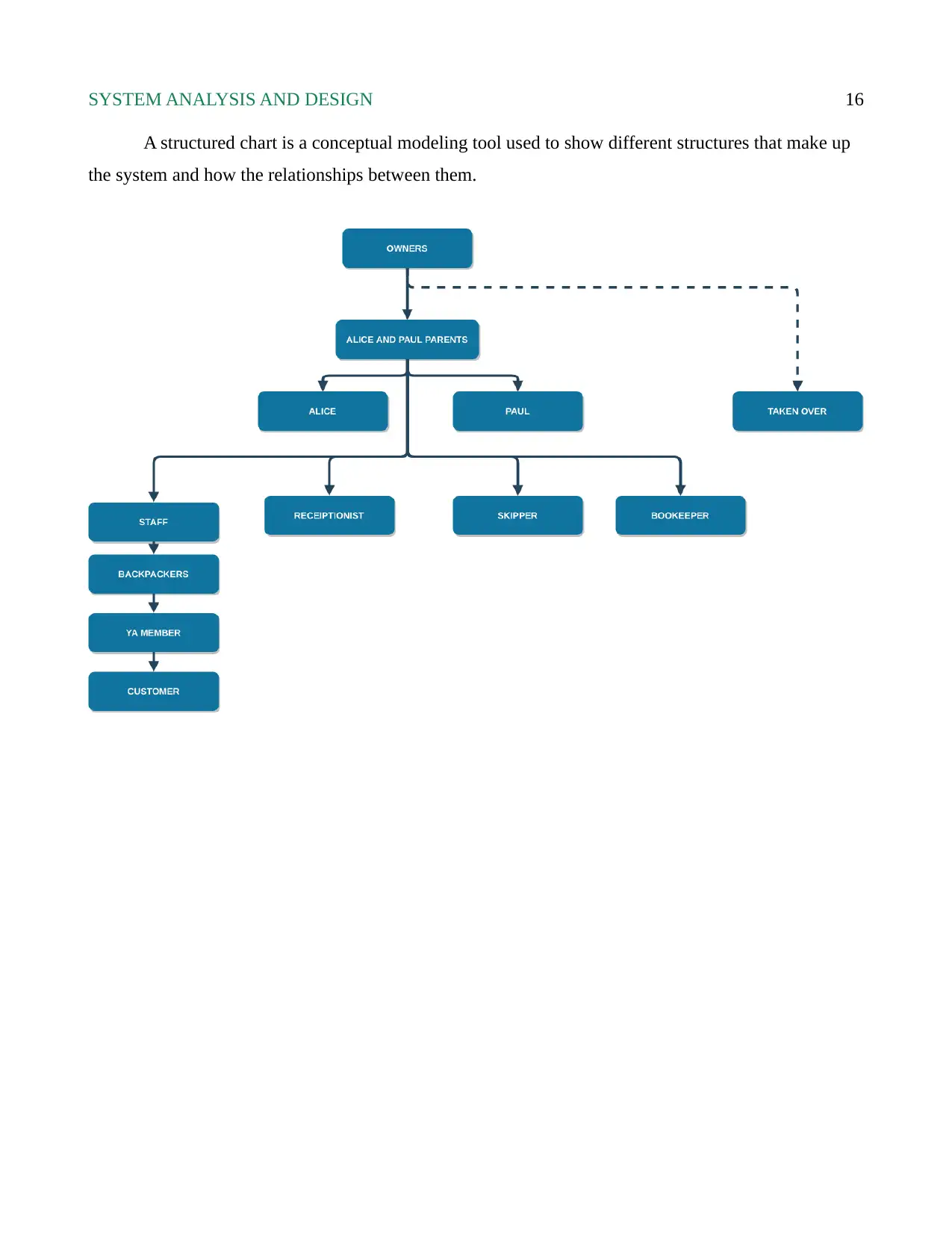
SYSTEM ANALYSIS AND DESIGN 16
A structured chart is a conceptual modeling tool used to show different structures that make up
the system and how the relationships between them.
A structured chart is a conceptual modeling tool used to show different structures that make up
the system and how the relationships between them.
Secure Best Marks with AI Grader
Need help grading? Try our AI Grader for instant feedback on your assignments.

SYSTEM ANALYSIS AND DESIGN 17
Program specifications
The first step in the design and development of a system which involves definition and analysis of the
type of system to be developed. The program specification must meet the following criterion.
The objectives must be stated – the main aim of the project is stated and defined.
Desired output is specified – the required output is stated. This ensures that when the system is
developed the actual output matches the desired output stated in the specifications. This ensures
that the product developed does not conflict with the desired specifications.
The required input is determined - the source and the type of data must be identified and stated.
The desire for a correct output is determined by the choice of the correct input.
Processing Requirements – the input data must be in correspondence to the output data. An
algorithm is used to determine the responsiveness of the output data to the input data.
Documentation - inputs, output and the requirements are documented after which the next
stage can then commence. Documenting all the steps is a technique to prevent occurrence of
errors in the future and act as a reference for other stages.
Program specifications
The first step in the design and development of a system which involves definition and analysis of the
type of system to be developed. The program specification must meet the following criterion.
The objectives must be stated – the main aim of the project is stated and defined.
Desired output is specified – the required output is stated. This ensures that when the system is
developed the actual output matches the desired output stated in the specifications. This ensures
that the product developed does not conflict with the desired specifications.
The required input is determined - the source and the type of data must be identified and stated.
The desire for a correct output is determined by the choice of the correct input.
Processing Requirements – the input data must be in correspondence to the output data. An
algorithm is used to determine the responsiveness of the output data to the input data.
Documentation - inputs, output and the requirements are documented after which the next
stage can then commence. Documenting all the steps is a technique to prevent occurrence of
errors in the future and act as a reference for other stages.
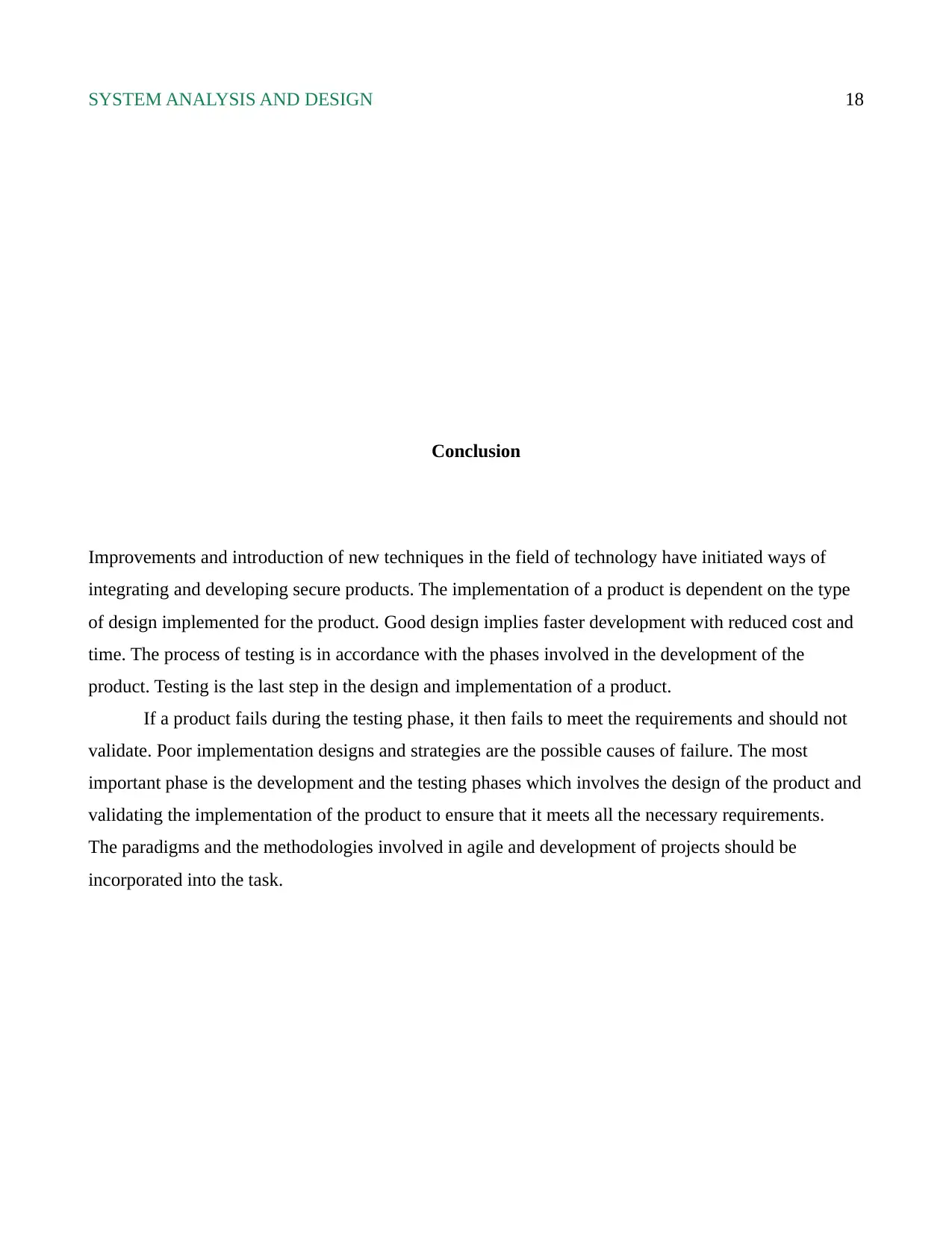
SYSTEM ANALYSIS AND DESIGN 18
Conclusion
Improvements and introduction of new techniques in the field of technology have initiated ways of
integrating and developing secure products. The implementation of a product is dependent on the type
of design implemented for the product. Good design implies faster development with reduced cost and
time. The process of testing is in accordance with the phases involved in the development of the
product. Testing is the last step in the design and implementation of a product.
If a product fails during the testing phase, it then fails to meet the requirements and should not
validate. Poor implementation designs and strategies are the possible causes of failure. The most
important phase is the development and the testing phases which involves the design of the product and
validating the implementation of the product to ensure that it meets all the necessary requirements.
The paradigms and the methodologies involved in agile and development of projects should be
incorporated into the task.
Conclusion
Improvements and introduction of new techniques in the field of technology have initiated ways of
integrating and developing secure products. The implementation of a product is dependent on the type
of design implemented for the product. Good design implies faster development with reduced cost and
time. The process of testing is in accordance with the phases involved in the development of the
product. Testing is the last step in the design and implementation of a product.
If a product fails during the testing phase, it then fails to meet the requirements and should not
validate. Poor implementation designs and strategies are the possible causes of failure. The most
important phase is the development and the testing phases which involves the design of the product and
validating the implementation of the product to ensure that it meets all the necessary requirements.
The paradigms and the methodologies involved in agile and development of projects should be
incorporated into the task.
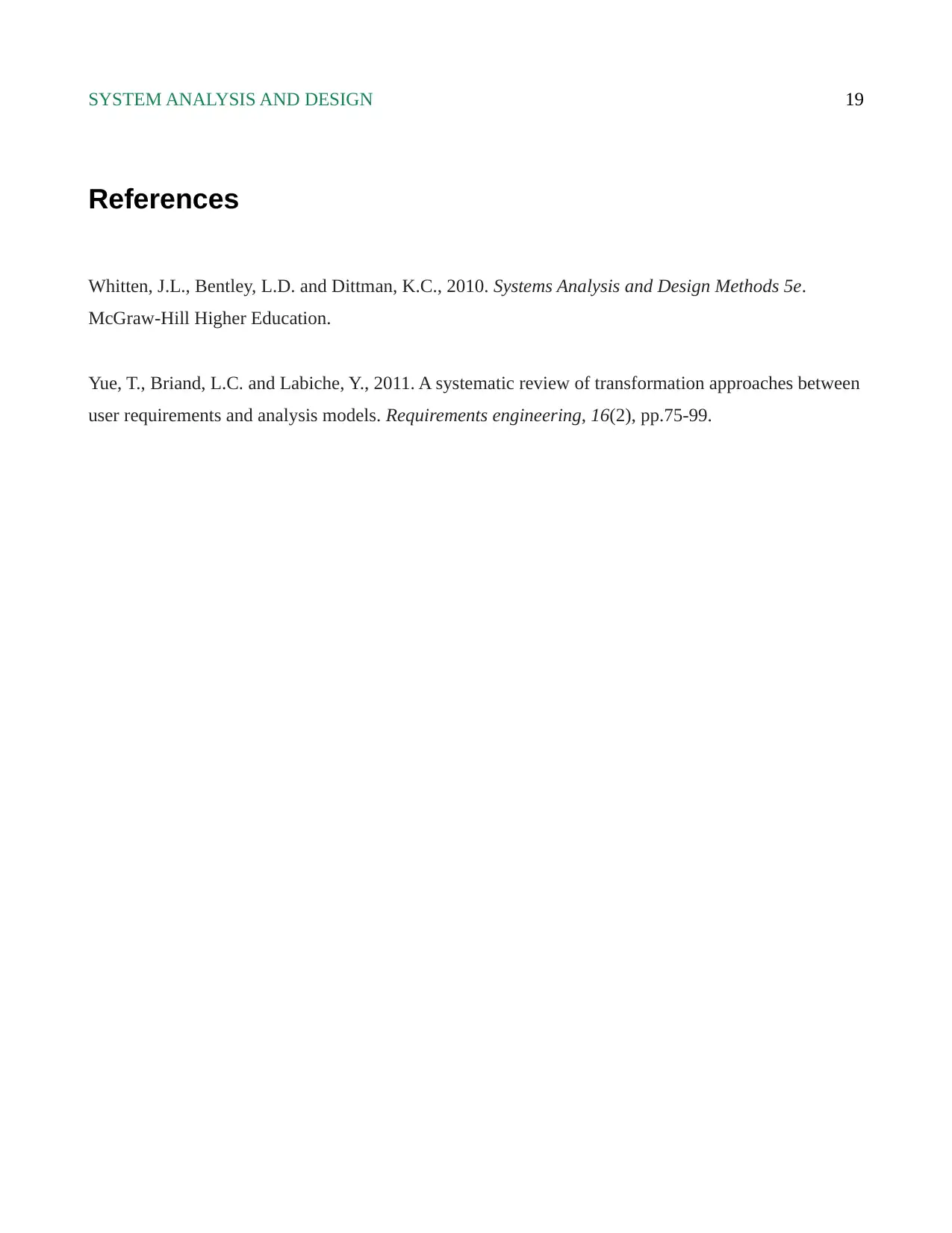
SYSTEM ANALYSIS AND DESIGN 19
References
Whitten, J.L., Bentley, L.D. and Dittman, K.C., 2010. Systems Analysis and Design Methods 5e.
McGraw-Hill Higher Education.
Yue, T., Briand, L.C. and Labiche, Y., 2011. A systematic review of transformation approaches between
user requirements and analysis models. Requirements engineering, 16(2), pp.75-99.
References
Whitten, J.L., Bentley, L.D. and Dittman, K.C., 2010. Systems Analysis and Design Methods 5e.
McGraw-Hill Higher Education.
Yue, T., Briand, L.C. and Labiche, Y., 2011. A systematic review of transformation approaches between
user requirements and analysis models. Requirements engineering, 16(2), pp.75-99.
1 out of 19
Related Documents
Your All-in-One AI-Powered Toolkit for Academic Success.
+13062052269
info@desklib.com
Available 24*7 on WhatsApp / Email
![[object Object]](/_next/static/media/star-bottom.7253800d.svg)
Unlock your academic potential
© 2024 | Zucol Services PVT LTD | All rights reserved.





